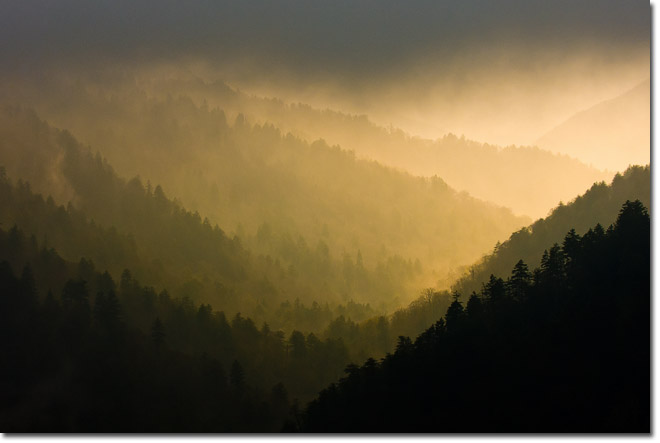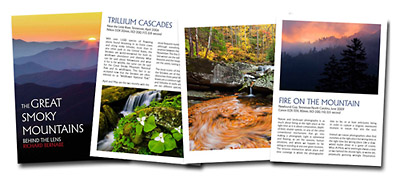Icons and a Breaking Storm |
The view from Morton Overlook, with its multi-layered and interlocking set of ridgelines, might be the nearest scene in the Great Smoky Mountains National Park that could be considered iconic. Photographers breezily call these scenes "icons" and depending on your artistic philosophy, this could be either a good or bad thing.
The reality here is that the only folks who care one way or the other about icons are other photographers. Too many icons in your portfolio might undermine your social standing among the camera literati. Morton, whoever he was, presumably snapped a photo here first and anyone who came along after him is a plagiarizing, no-talent hack. Exhibiting amazing foresight, he even placed a sign before the vista with his name emblazoned across its front, just to prove he did it first.
Of course I am kidding.
Photographic icons are icons because the scene possesses an easy, visual aesthetic that appeals to a wide range of people. When a photographer walks up to one of these scenes, there's an initial instinct to photograph it a certain way because, a) human beings tend to see things the same way, especially those trained in the visual arts, and b) the photographer has seen this image before and he or she liked it and now wants to possess it. This makes icons an easy target for the beginner: a ready-made, aesthetically appealing composition that only needs some technical tweaking before pressing the shutter, not to mention a nearly guaranteed success.
For the seasoned photographer, an icon is too easy, unoriginal, and lacks the pure pleasure of discovering a unique, personal vision of one's own. Empty calories, you might say.
I can appreciate both their virtues and sins and come down squarely on the fence in this friendly debate. Icons are fun, particularly when you see one for the first time. They are, after all, icons for a damned good reason. And if it's not your first time, finding a unique take on a tired concept can be fun and exciting endeavor.

In this particular case, the image was more about the unique atmospheric conditions rather than a new and improved composition, of which there are very few from this vantage point. A stalled low-pressure system over east Tennessee had me hiking and slogging through mud and rain for five straight days and it was wearing on me. When I sensed some clearing, I wanted to wait out the remainder of the storm from a high-elevation vista where I could take advantage of any drama between developing light and clouds. Morton Overlook was my first stop.
When I saw that the ridges were visible and the clouds lifting, I decided it would be my last stop as well, icon or not. It was just past 4 p.m. in early April so any sunlight that did happen to break through the clouds would be low-angled and warm-toned. The scene would also be backlit, a boon for even more dramatic light with the moisture-laden air, mist, and remnants of fog drifting through the valley.
I selected a telephoto lens to compress and flatten the scene, and to leave out any featureless sky or messy foreground. The repeating lines and "V" shapes created by the intersecting ridge lines help move the eye effortlessly through the scene diagonally from the bottom to the upper right corner. It had balance, flow, and building drama. The only missing ingredient was light!
But it never really came together as hoped. For five minutes or so, warm, filtered light illuminated the valley for a bit of subtle drama, but not the epic light show that my imagination had painted for me. But it's a moody, evocative image that stirs my imagination and represents a bit of real and metaphorical sunshine after a particularly dreary week.
This essay is an excerpt from Richard's just-released eBook
Great Smoky Mountains: Behind the Lens
Comments on NPN nature photography articles? Send them to the editor. NPN members may also log in and leave their comments below.
 NPN Editor-in-Chief, Richard Bernabe has been a full-time professional nature photographer and writer since 2003. He's had thousands of publishing credits in books, magazines, and calandars and regularly leads photography tours and workshops all across the United States and internationally in places like Patagonia, Iceland, and Peru.
NPN Editor-in-Chief, Richard Bernabe has been a full-time professional nature photographer and writer since 2003. He's had thousands of publishing credits in books, magazines, and calandars and regularly leads photography tours and workshops all across the United States and internationally in places like Patagonia, Iceland, and Peru.
For more information about Richard's photography, be sure to visit his personal website, Richard Bernabe Photography.
